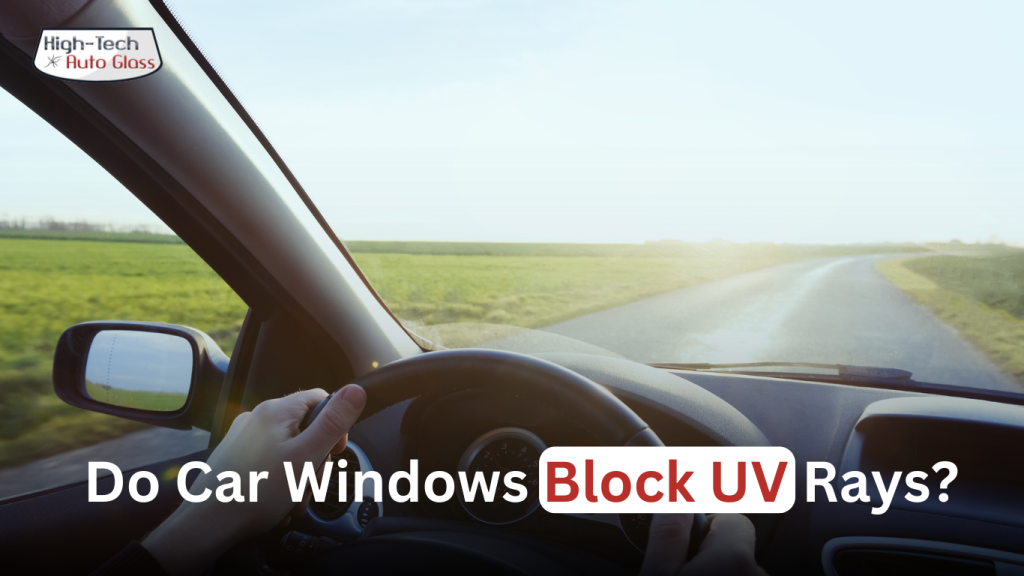Do Car Windows Block UV Rays

We all know that sunlight feels good while driving, but have you ever wondered if your car windows protect you from harmful UV rays? UV radiation comes in two main types—UV-A and UV-B—both of which can harm your skin and eyes over time. Surprisingly, not all car windows block UV rays equally, which could leave drivers and passengers vulnerable.
Understanding how UV protection works in vehicles is essential for your health. Whether it’s your side windows, windshield, or even the rear glass, each plays a different role in shielding you. Let’s explore what your car windows really do to block UV light and how you can stay protected on the road.
Ultraviolet (UV) radiation from the sun comprises two primary types that reach the Earth’s surface: UV-A and UV-B rays. Understanding their differences is crucial, as each affects our health in distinct ways.
Understanding UV Radiation
Differences Between UV-A and UV-B Rays
- UV-A Rays (315–400 nm): These rays have longer wavelengths and account for approximately 95% of the UV radiation reaching the Earth’s surface. They can penetrate deep into the skin’s dermis, leading to skin aging and wrinkling. UV-A rays can also pass through window glass, including car windows, which means exposure can occur even while indoors or driving.
- UV-B Rays (280–315 nm): Making up about 5% of the UV radiation that reaches us, UV-B rays have shorter wavelengths and are primarily responsible for causing sunburn. They directly damage the DNA in skin cells, which can lead to skin cancer. Unlike UV-A, UV-B rays are mostly absorbed by the ozone layer and do not penetrate glass effectively.
Health Implications
According to the World Health Organization, UV-A rays can penetrate glass and pose long-term risks, including premature aging and eye damage.
- Skin Cancer: Both UV-A and UV-B radiation are classified as carcinogenic to humans. Prolonged exposure to these rays increases the risk of developing skin cancers, including melanoma, basal cell carcinoma, and squamous cell carcinoma.
- Premature Aging: UV-A rays penetrate deeply into the skin, affecting connective tissues and blood vessels, which leads to a loss of skin elasticity and premature aging.
- Eye Damage: Exposure to UV radiation can harm the eyes, potentially causing conditions like cataracts and photokeratitis. Wearing sunglasses that block 99% to 100% of UV-A and UV-B rays can help protect your eyes.
Understanding these differences underscores the importance of comprehensive UV protection, even while inside vehicles, to safeguard both skin and eyes from potential damage.
UV Protection Offered by Different Car Windows
Windshields: The Most Protective
Windshields are typically made from laminated glass, which consists of two layers of glass with a plastic interlayer in between. This design is not only for safety but also helps block almost 100% of UV-B rays and approximately 97–99% of UV-A rays.
Scientific studies confirm that laminated windshields significantly reduce UV-A exposure, offering superior protection compared to other car windows. (Source: Skin Cancer Foundation)
Side and Rear Windows: Limited UV Protection
Side and rear windows are usually made of tempered glass, which is stronger than regular glass but offers less UV protection.
- UV-B Rays: Most tempered glass blocks UV-B rays effectively.
- UV-A Rays: A large portion of UV-A rays (up to 70%) can pass through these windows, exposing occupants to potential skin damage and premature aging.
UV protection here varies greatly based on the manufacturer and any factory-applied or aftermarket coatings.
Sunroofs: A Mixed Bag
Sunroofs vary widely in their ability to block UV radiation:
- Standard Sunroofs: Often made of tempered glass, they provide minimal UV protection, especially for UV-A rays.
- UV-Protective Sunroofs: Some vehicles offer sunroofs with factory-installed UV-blocking coatings, which can significantly reduce exposure.
Why Does This Matter?
The differences in UV protection among car windows mean that passengers, especially those sitting near side windows or under sunroofs, can still be exposed to harmful UV-A rays. This makes it essential to take additional precautions, such as applying UV-blocking window films, wearing protective sunglasses, or using broad-spectrum sunscreen during long drives.
By understanding how different car windows perform, you can make informed decisions to protect yourself and your passengers from harmful UV exposure.
Common Misconceptions About UV Protection in Vehicles
Many drivers assume their car windows provide complete protection from harmful UV rays, but this isn’t entirely true. Here are four common misconceptions explained:
All car windows block UV rays completely.
This is one of the biggest myths. While windshields are designed to block almost all UV-B and a significant portion of UV-A rays, side and rear windows often let a considerable amount of UV-A rays through, exposing passengers to potential skin damage.
Tinted windows provide full UV protection.
Tints primarily reduce glare and heat but don’t necessarily block UV radiation unless specifically treated with UV-blocking technology. Many standard tints offer little to no UV-A protection.
Sunroofs offer the same UV protection as regular windows.
Standard sunroofs are typically made of tempered glass, which blocks only UV-B rays, leaving occupants vulnerable to UV-A exposure. Without UV-protective coatings, they provide minimal shielding from the sun’s harmful effects.
You can’t get sunburned inside a car.
While car windows block UV-B rays responsible for sunburns, UV-A rays penetrate deeper into the skin and can cause long-term damage such as wrinkles and even skin cancer. Prolonged exposure, especially through side windows, can still lead to harmful effects even if you don’t see immediate sunburn.
Tips for UV Protection While Driving
Driving exposes you to UV rays, especially through side and rear windows, so taking proactive steps to protect yourself is essential. Here are some practical and easy-to-follow tips:
- Apply UV-Blocking Window Films:
Consider installing aftermarket UV-blocking films on your car’s side and rear windows. These films can block up to 99% of UV-A and UV-B rays, providing an extra layer of protection, especially if your car doesn’t come with factory-installed UV coatings. - Wear UV-Protective Sunglasses:
Invest in sunglasses labeled with 100% UV protection. These will shield your eyes from harmful rays that can cause cataracts and other eye issues, even when driving under a shaded sunroof or through side windows. - Use a Broad-Spectrum Sunscreen:
Apply sunscreen with at least SPF 30 on exposed skin before you start driving. This is especially important for long road trips or daily commutes where one side of your body is constantly exposed to sunlight through the car windows. - Cover Your Skin:
If applying sunscreen regularly feels like too much effort, opt for lightweight, UV-protective clothing or sleeves that cover your arms and neck. Many companies offer clothing designed specifically for UV protection. - Park Smartly:
Whenever possible, park your car in shaded areas or use a windshield sunshade to reduce UV exposure inside your vehicle. This not only protects you but also helps prevent your car’s interior from fading due to prolonged UV exposure.
By combining these simple tips, you can significantly reduce your risk of UV-related skin damage and eye problems while enjoying a safer and more comfortable driving experience.
Conclusion
Driving may seem safe from the sun’s harmful effects, but not all car windows provide full UV protection. While windshields are typically designed to block most UV rays, side and rear windows often fall short, exposing drivers and passengers to potential risks. Investing in car window glass UV protection like UV-blocking films or sun shields for the driver’s side window can greatly reduce exposure to harmful UV radiation. These measures are crucial for blocking the sun from car windows and protecting your skin and eyes during daily commutes or long road trips.
If you’re in Arizona or the surrounding areas and need expert services for your windshield, look no further than High-Tech Autoglass. They offer top-notch windshield replacement in Phoenix and surrounding areas, ensuring your vehicle is equipped with the highest-quality glass for both safety and UV protection. Whether it’s a repair or a full replacement, their expertise ensures your car is not only road-ready but also safer from UV exposure. Take the step today to enhance your UV ray protection for car windows and drive with peace of mind.
Frequently Asked Questions
Can I get sunburned through my car windows?
Yes, even though windshields provide UV protection, side and rear windows often allow UV-A rays to pass through, which can lead to skin damage. Using a car window sun blocker or applying sunscreen can help reduce exposure.
Does glass block UV rays completely?
No, not all glass blocks UV rays. While windshields typically block UV-B and most UV-A rays due to laminated glass, side windows require additional treatments, such as auto glass UV protection, to shield occupants effectively.
Do tinted windows block UV rays?
It depends on the type of tint. Standard tints may reduce glare and heat but don’t always block UV rays. For effective UV shielding, look for tints or films labeled for automotive glass UV protection.
Is it necessary to use sunscreen for your windshield?
Yes, applying sunscreen is recommended, especially during long drives. Even with a sunblock for windshield or UV-treated glass, small amounts of UV-A rays can penetrate, leading to skin damage.
Are car side windows UV-protected?
Not all car side windows come with UV protection. If your car lacks UV-treated glass, consider installing a sun shield for the driver’s side window or using sun screens for car side windows to block harmful rays.
What’s the best way to block the sun from car windows?
The most effective options include installing UV-blocking window films, using car side window sun blockers, or choosing cars with factory-installed UV-protective glass. These options provide reliable UV ray protection for car windows.
Does car tint block UV rays?
Some tints are designed to block UV rays, but not all do. Always check for films specifically made for auto window sun blocker purposes to ensure proper protection.
Are there sun protectors for car windows available?
Yes, you can find various car window sun blockers and films on the market. They not only protect against UV rays but also help reduce heat inside the vehicle.
